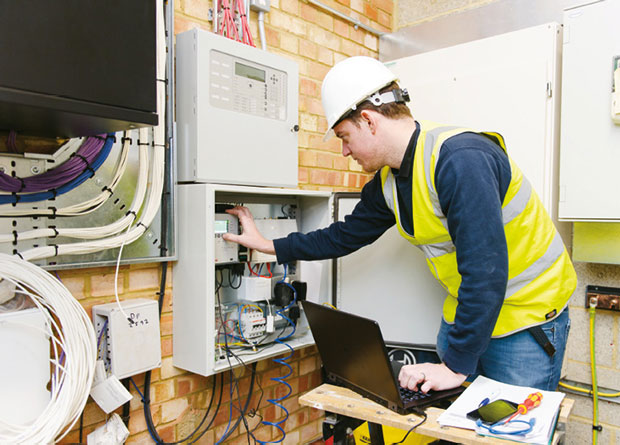 Toby Steel, Head of Client Services at Insite Energy, shares some tips for optimising communal heating systems
Toby Steel, Head of Client Services at Insite Energy, shares some tips for optimising communal heating systems
Heat networks offer big carbon and cost savings in residential properties, and growth in the sector is booming thanks to strong Government backing. Not all heat networks live up to their promise, however, because not all are operated and managed effectively.
To achieve a heat network’s full potential energy savings, facilities managers must continuously and meticulously measure and monitor its performance, correcting issues as soon as they occur. Having a clear understanding of what optimum functioning looks like means faults can be spotted quickly.
While constant monitoring might seem like a lot to manage, it’s well worth the effort. Enhancing efficiency by 10 per cent within a 50-unit development can reduce costs by £9,612/year, while a 20 per cent advancement could save £16,121. Improved performance also means lower emissions and longer lasting, safer equipment. With new emerging technologies, such as cloud-based dashboards with real-time data, consistent monitoring is now far easier.
Precise, accessible, up-to-the-minute, and comprehensive performance data is vital for optimising a heat network. Besides revealing faults, it provides essential insights into occupancy rates and peak usage periods, enabling accurate tailoring of heat supply to minimise network losses.
But what if you don’t have the latest smart meters or monitoring technology to work with? There are still steps you can and should take to optimise your heat network.
MAINTENANCE MATTERS
Above all, make sure a comprehensive maintenance regimen is implemented, covering every part of the system, including meters and heat interface units (HIUs). Heat network maintenance differs significantly from that of ordinary gas boilers. As multiple properties are all connected, a change to one asset can have an impact on the entire network. Ensure potential service providers can explain this in detail and their strategies for optimising efficiency and minimising heat loss.
It’s also worth checking contractors’ familiarity with CIBSE’s CP1 for Heat Networks: Code of Practice 2020. While adherence to these standards isn’t yet required legally, engineers should certainly be abreast of their contents. When Ofgem’s UK heat network regulations will be released in 2025, rules are likely to become more stringent.
Once you find someone with the right expertise, do take note of their suggestions. We constantly offer our clients ideas on how to reduce energy waste and enhance efficiency. Although there may be an upfront investment involved, we wouldn’t make these recommendations if the cost/benefit ratio wasn’t compelling.
TARIFF CHANGES
FMs and energy managers should also be cognisant of changes in energy tariffs as, if not acted upon quickly, these can cause major headaches in the form of incorrect recovery of funds from residents. At the same time, with energy prices still very unpredictable, they should be wary of signing up to long-term contracts.
Tariff changes often happen when suppliers change, so set a diary reminder eight weeks prior to contract changeovers to proactively adjust the heat network rate charged to residents, making sure to give them as much notice as possible. Loop in your metering and billing provider, too, so they can advise you and ensure your residents are billed correctly, and your maintenance crew, so they can arrange any engineer visits. This is also a good time to ensure you have the necessary approvals and access for meter-fault repairs. You know your residents best, so keep your suppliers informed of how and when to best contact them.
If the energy tariff has already changed, conduct an urgent customer-tariff review and financial analysis to ascertain how much of any deficit is recoverable by each household and at what rate, for example a recovery rate of 25 per cent may need to be added to top-ups made to a PAYG account.
It may be counterintuitive, but the heat in empty areas of the building(s) should not be turned off. It can take a while to get back online and there could be risk of network water contamination, making the system less efficient, or mould build-up in the property if the temperature drops below 16oC. Instead, factor the cost of voids into your heat tariffs and/or keep a contingency fund to cover them. The metering and billing provider should be able to help with this.
POWER OUTAGES
Lastly, make sure you’re prepared for power outages. How old is your equipment? Do you have surge protectors? If you’ve had outages before, what was the issue and how can you prevent it in future? As heat networks become more common in rural areas, the risk of outages may be increasing.
Similarly, consider what steps you can take to prevent internet connection issues. If communications are down, the systems and organisations supporting you with data analysis, metering and billing won’t be able do their jobs. Data management software can help you monitor this and see if it’s a recurring issue. Installing a 4G router as a backup may also be a good solution to ensure you’ll have access to data even when other channels are down.
Management of heat networks is complex. They are big, complicated, high-value systems with multiple stakeholders. But for these very reasons, investing in their efficiency and longevity is undoubtedly worthwhile.





